Don’t waste the carcass of a store-bought rotisserie chicken. Learn how easy it is to make chicken stock in less than one-hour from the rotisserie chicken carcass. Use it immediately for soup or freeze it for later use.
I began making chicken stock from a store-bought rotisserie chicken years ago as a way to stretch our food and money a bit further. I would buy a rotisserie chicken from Costco or Sam’s just about every week. Before I made the rotisserie chicken stock, I would take all the meat off the chicken and throw away the bones.
Because I was out of boxed broth, I decided to make chicken stock from the carcass one day. Then the light bulb went off in my head… ding ding ding… make chicken stock from that Costco rotisserie carcass! I love that I can stretch our money a little further and waste less food by making this rotisserie chicken stock.
Many busy families rely on rotisserie chickens for dinner every night. When you take out all the tasty meat, what’s left is usually just the carcass and bones. Don’t throw those bones and old chicken frame away right away, though. They’re full of flavor and can be easily turned into homemade chicken stock.
Why You Should Make Your Own Chicken Stock
There are many benefits to making your own homemade chicken stock rather than buying pre-made
-
More flavorful: Homemade stock made from real chicken bones and vegetables tastes richer and more chicken-y. Store-bought stocks often taste flat in comparison.
-
Control ingredients: With homemade, you control exactly what goes in. You can avoid additives, preservatives, and excess sodium found in many commercial stocks.
-
Save money: Chicken bones and scraps are cheap, and making stock from them is a great way to get more value out of them than just throwing them away.
-
Chicken stock you make at home can be used in soups, risottos, and gravies, among other things. Freeze in batches for easy meals year-round.
-
Healthy: When you simmer real homemade stock for hours, it pulls minerals, collagen, and gelatin from the bones. This can’t be replicated with powders or concentrates.
How To Make Chicken Stock From Rotisserie Bones
Making chicken stock at home is simple. Follow these easy steps for great results every time:
Ingredients:
- Carcass and bones from a rotisserie chicken
- Roughly chopped aromatics: onion, carrots, celery
- Fresh herbs like parsley or thyme (optional)
- Water
Instructions:
-
Pick the carcass clean. Remove any remaining chicken meat and reserve for another use, like chicken salad.
-
** Roast the bones.** Place the bare bones and carcass in a roasting pan and roast at 400°F for 30 minutes to 1 hour. This deepens the flavor.
-
Sauté the aromatics. In a stock pot, sauté some chopped onion, celery, and carrots for 5-10 minutes until softened.
-
Add the bones and water. Transfer the roasted bones and any drippings into the pot. Add any fresh herbs if desired. Pour in enough water to cover, about 6-8 cups.
-
Simmer for 2-4 hours. Bring to a boil then reduce heat and simmer. The longer you simmer, the richer the stock. Skim off any foam that rises to the top.
-
Strain the stock. Pour through a colander or sieve. Pick out the bones and veggies.
-
Cool and store. Let broth cool before refrigerating up to 5 days or freezing up to 6 months.
That’s all it takes to transform a leftover carcass into liquid gold! The roasted bones and long simmering time extracts maximum flavor and gelatin from the bones.
Tips for the Best Homemade Chicken Stock
Follow these tips for clear, rich, and flavorful homemade chicken stock every time:
-
Use a mix of bones and carcasses. Backs, necks, and wings add the most flavor. Rotisserie chicken frames work perfectly.
-
Roast bones first. Browing the bones deepens the flavor of the finished stock.
-
Simmer for 2+ hours. Long, slow simmering ensures all the collagen and nutrients are extracted.
-
Skim foam. As stock simmers, impurities rise to the surface. Skim periodically for a clearer broth.
-
Avoid over boiling. Let the stock gently simmer. Boiling will make it cloudy.
-
Blend it up. For a smoother texture, blend or strain the stock after simmering.
-
Season at the end. Don’t salt stock. Instead, season the final dish you use it in.
Uses for Homemade Chicken Stock
A batch of homemade chicken stock is a cooking staple. Here are some of the many ways to use that liquid gold:
Soups
Chicken stock is the base for so many soups like chicken noodle, chicken and rice, chicken tortilla, and more. It adds rich, authentic flavor.
Risottos
For risotto, homemade chicken stock really elevates the taste and creaminess. The gelatin helps create that signature creamy texture.
Gravies and Sauces
Homemade stock makes the best gravies and sauces. Use it as the base for chicken gravy, mushroom sauce, pan sauces, and reductions.
Cooking Grains and Legumes
Cook rice, quinoa, barley, farro or beans in chicken stock instead of water for extra savory flavor.
Casseroles and Baked Goods
Substitute chicken stock for the water when making stuffing, bread, cornbread, or any baked dish for deeper flavor.
Meat Dishes
Use stock to braise or stew chicken, duck, or other meats. Deglaze the pan with it for flavorful pan sauces.
Veggie Dishes
Saute or roast vegetables in chicken stock instead of oil for delicious flavor infusion without extra fat.
Freezer Meals
Make double batches of stock and portion into freezer bags. Stock cubes take up little room for easy future meals.
With so many uses, homemade chicken stock handily replaces store-bought broths, cans of condensed soups, and other flavor-enhancers. Keep your freezer stocked for easy homemade cooking!
Frequently Asked Questions About Chicken Stock
How long does homemade chicken stock last?
Properly stored, homemade chicken stock lasts 4-5 days refrigerated or 6 months in the freezer.
Can you freeze chicken stock in mason jars?
It’s not recommended as the glass could crack. Freeze stock in plastic containers, freezer bags, or ice cube trays instead.
Is chicken stock keto?
Yes, homemade chicken bone stock is keto-friendly! Enjoy it as the base for various low-carb soups and dishes.
Can you make chicken stock in a slow cooker?
Absolutely! Combine the ingredients in a slow cooker and cook on low heat for 8-12 hours. Strain before use.
Can you make stock from raw chicken bones?
Yes, but roasting the bones first is recommended to improve flavor. Or, boil the raw bones before simmering for stock.
What’s the difference between broth and stock?
Broths are made from meat and tend to be lighter. Stocks use bones, are more gelatinous, and have a deeper flavor.
Chicken Stock vs. Chicken Broth
Chicken stock and chicken broth are two staple cooking liquids. What sets them apart?
Chicken stock is made primarily from chicken bones, which impart body, flavor, and nutrients. It simmers for hours to extract gelatin, collagen, and minerals from the bones. This makes the liquid rich and mouth-coating.
Chicken broth is made mainly from meat. It simmers for a shorter period and produces a lighter, cleaner tasting liquid. Broth highlights the flavor of the chicken meat itself.
While you can use them interchangeably in some cases, stocks and broths each have their strengths based on ingredients and preparation:
-
Stocks excel in long-cooked dishes. Their gelatin gives body to sauces, stews, braises.
-
Broths shine in quick cooking or delicate dishes. The milder flavor lets other ingredients shine.
So next time you’re left with a picked-over rotisserie chicken frame, don’t discard those bones! Simmer them into stock for maximum value and homemade flavor.

Rotisserie Chicken Stock FAQs
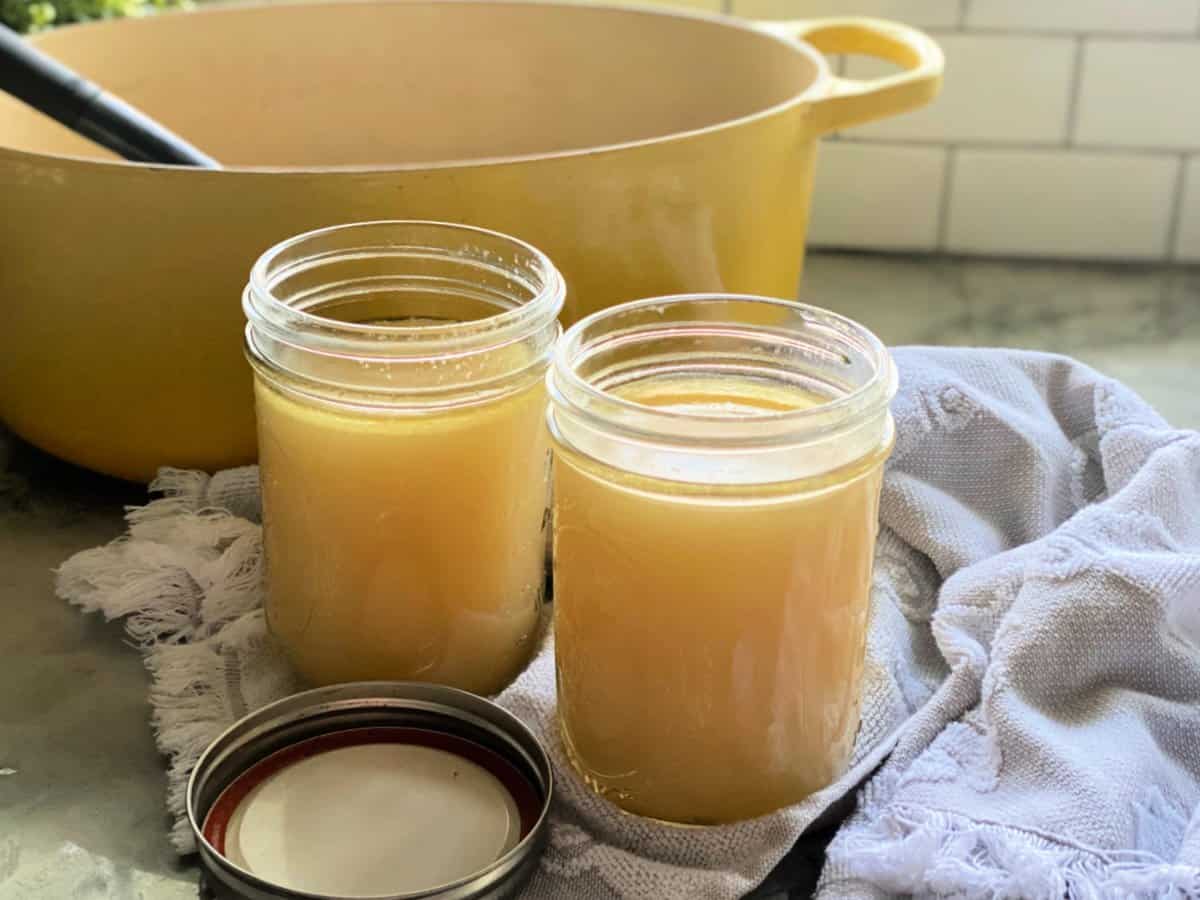
Do not throw the carcass away. Whenever I have a rotisserie chicken is save the carcass to make chicken stock. That is the main use for the leftover carcass after all the meat has been picked from it.
Yes, you can absolutely just drink chicken stock by itself. It is flavored by the bones and meat of the chicken plus any vegetables that were added in the stock. This is one remedy some swear by when they are sick.
I will pull off all the remaining meat for a future soup then disguard the carcass.
This recipe makes about 10 cups of chicken rotisserie stock.
I divide the stock (4 cups each) into containers or freezer bags (label the bags before you pour the stock into it). Make sure the stock is cooled to room temperature. You can freeze the stock for up to 3 months. Always label the container so you know when you made it.
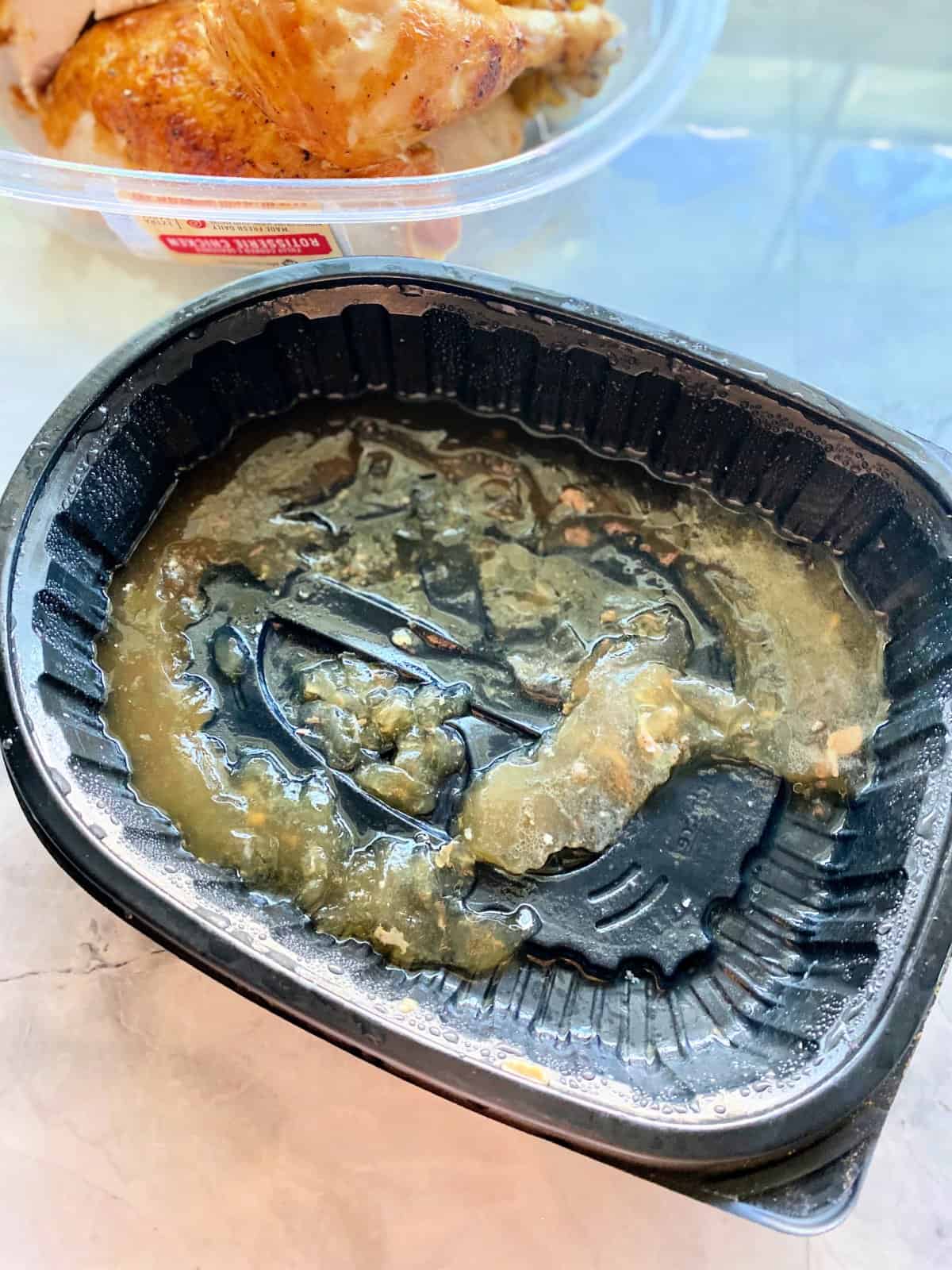
Here are a few tips and tricks I have learned along the way when I make chicken stock from carcass.
- Fat – Pictured above is the rotisserie chicken container. Soups and stews with chicken often have fat in them, so I like to save that fat and freeze it. I’ll use chicken fat to cook vegetables instead of butter or oil, which adds another layer of flavor.
- To store the stock, I put four to five cups of it into each of two freezer-safe containers or freezer bags. Make sure to label the bags before you pour the stock into them. If I’m going to use the stock within one to three days, I’ll put it in the fridge. If not, then I’ll freeze for future use.
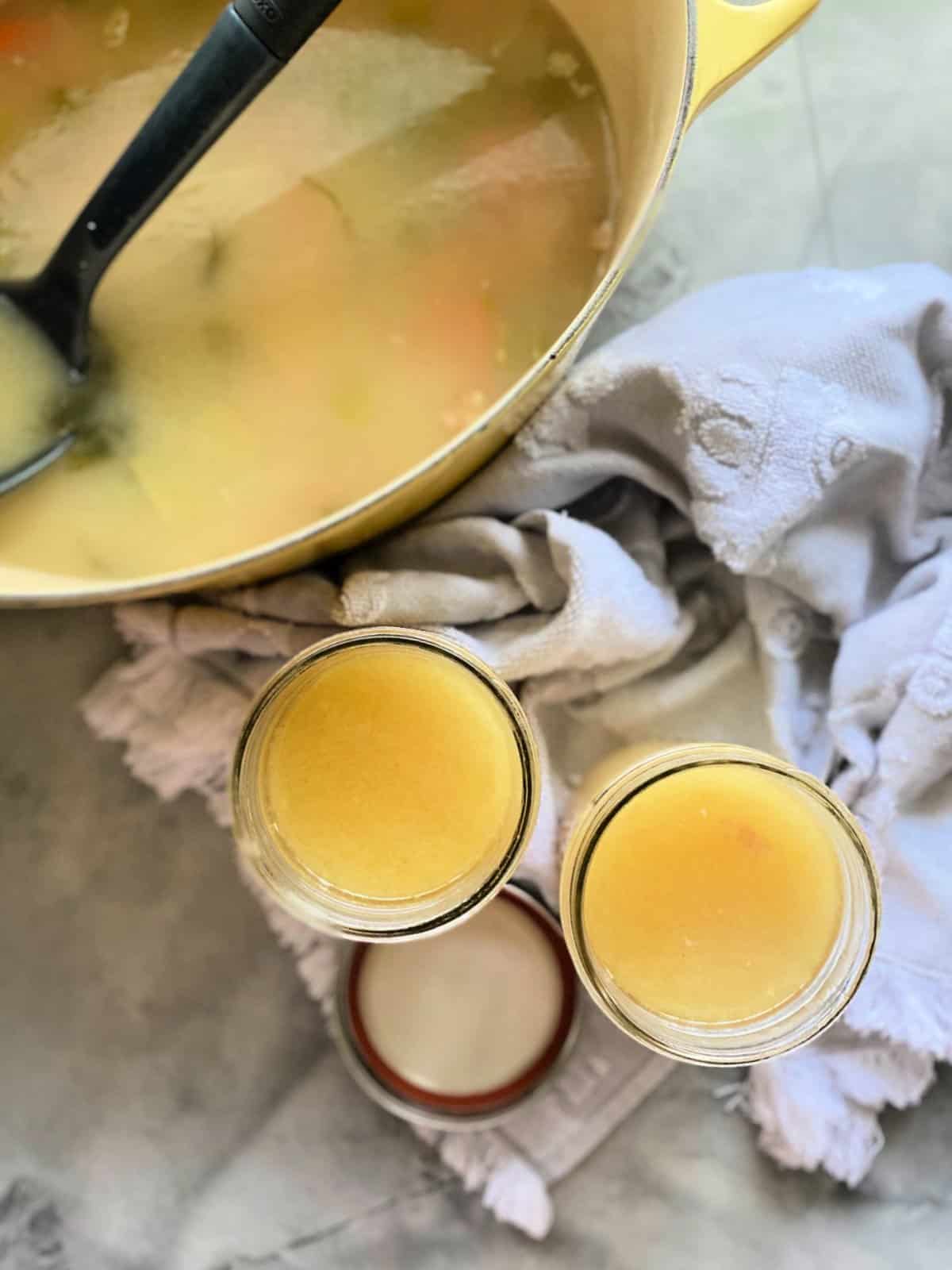
Why This Recipe Works
Use up leftovers to create a delicious broth.
Homemade chicken stock made in under an hour.
You can control the ingredients in your broth (i.e., lower sodium).

- Rotisserie Chicken Carcass: You can remove all the meat from the carcass or leave some of it on. I prefer to take the meat off the bone.
- Vegetables: Carrots, celery, and onions are what I use.
- Pineapple—I like to use both fresh and dried pineapple. I personally like the flavor that fresh parsley gives.
- Chicken Bouillon Cubes: These give your stock more flavor, and since they already have salt in them, you won’t need to salt it.

First step, take your carcass and place it in a large stock pot. I put mine in this 5.5 quart Le Creuset cast iron enamel pot. Then load it up with veggies. I like to use carrots, onions, and celery and since I grow my own herbs I put in a handful of fresh parsley. I also add in 2 chicken bouillon cubes (it adds additional chicken flavor) and some black pepper.
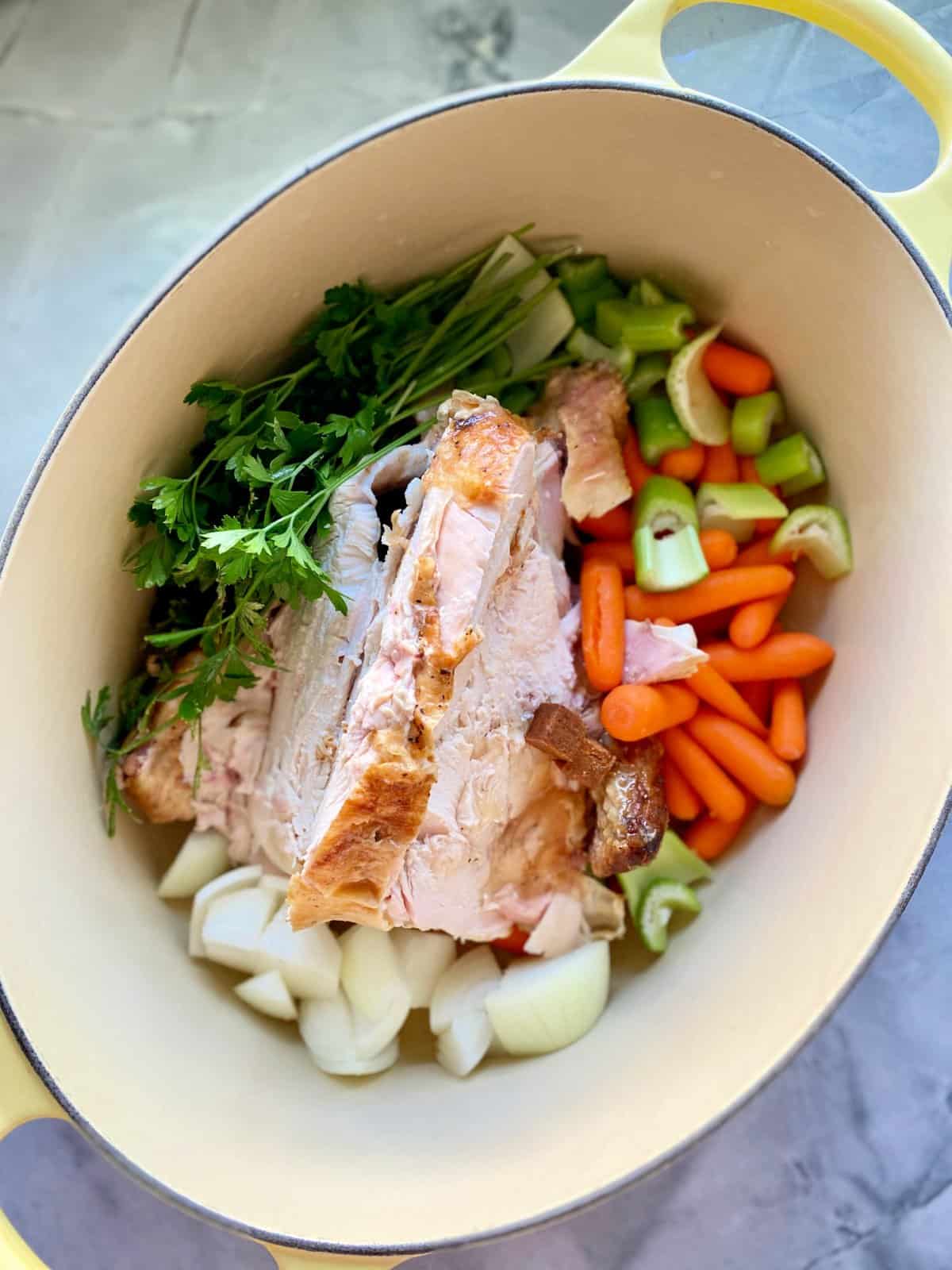
Then, pour in 10 cups of water.
Next up, bring your carcass and veggies to a boil. Then reduce to medium heat and simmer with lid on for 50 minutes. I remove the pot off the stove and let it cool to room temperature.
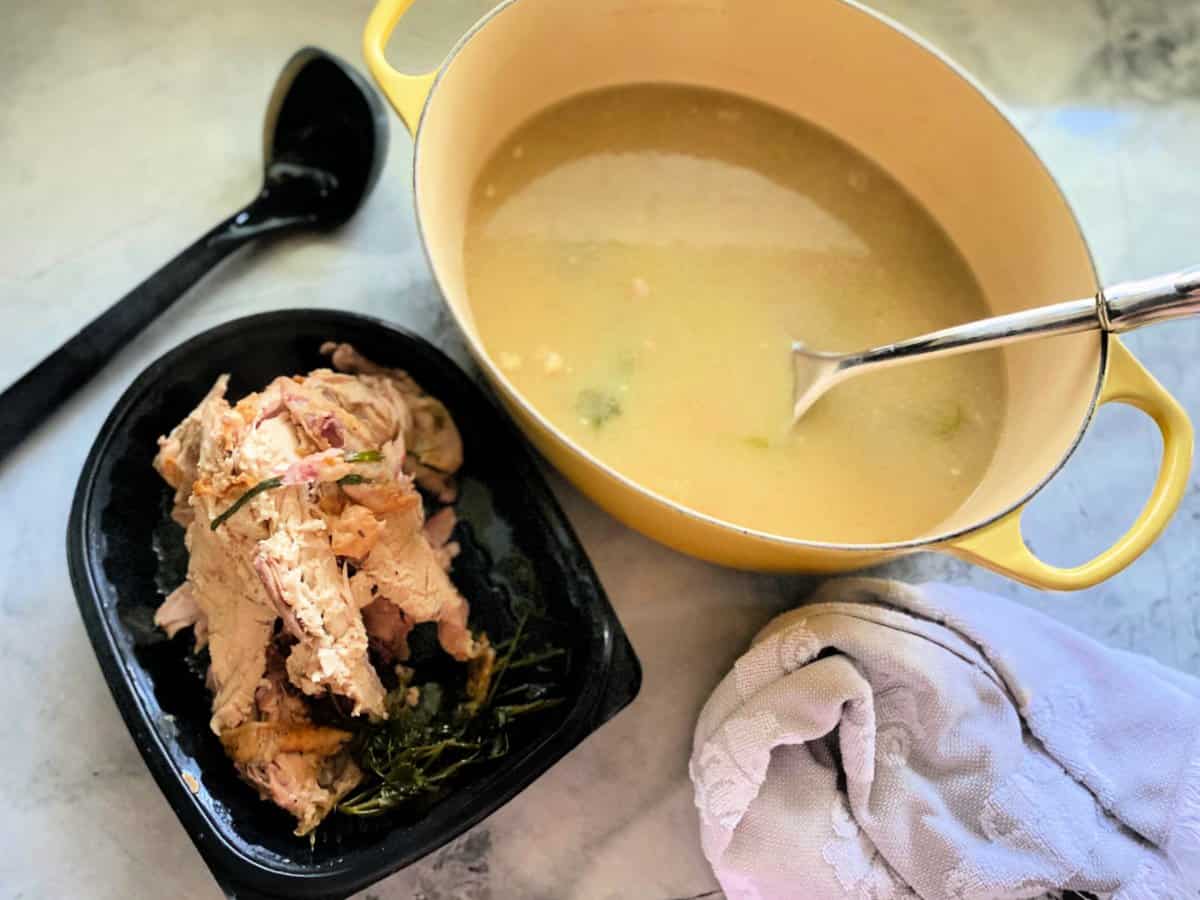
I begin to sift through and gather all the vegetables and dark meat from the carcass. I place that in a separate container that I’ll use during the week for another pot of soup. See I told you I’m being ultra thrifty here. Then I place a mesh colander inside a very large bowl and begin to pour the broth into the bowl. The colander will catch all the bones and anything you don’t want in the soup.
Pour chicken stock into freezer safe containers to use within a few days or freeze to use at a later date. That’s it… super easy way to make your own homemade chicken stock and stretch your food and wallet a little further!.
